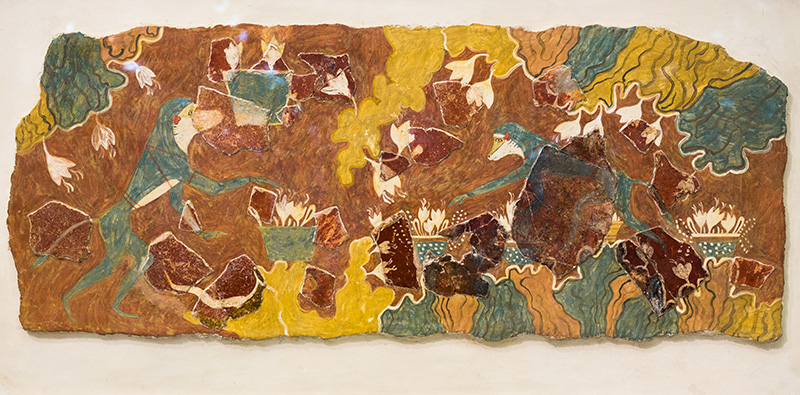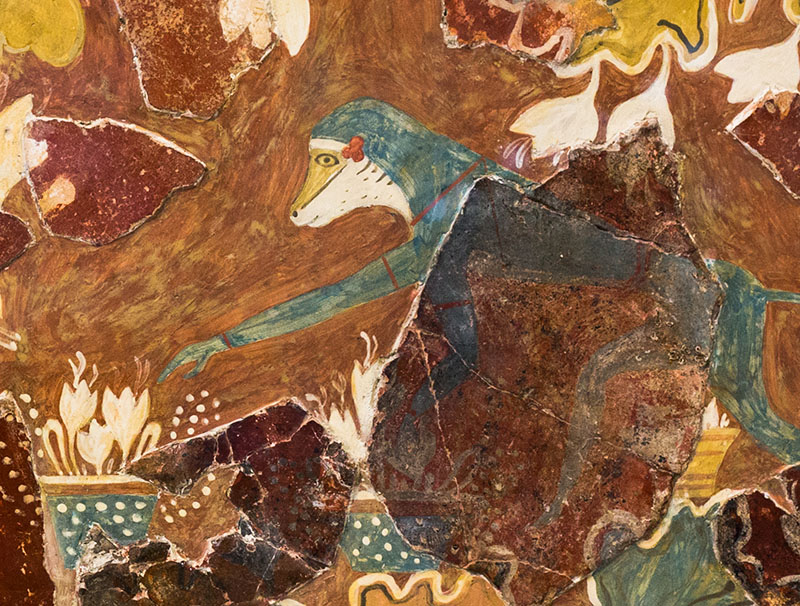Vibrant Visions: The Frescoes of Knossos and Their Decorative Legacy
Click on images to enlarge them and view captions.
by Shirley Wei
The morning sun cast long shadows across the reconstructed walls of the Palace of Knossos as participants on the Decorative Arts Trust’s Greece Study Trip Abroad followed the winding path through Europe’s oldest civilization. While mainland Greece was still developing its cultural identity, the Minoans of Crete had already established a sophisticated artistic tradition that would influence decorative arts for millennia to come. The walls of this Bronze Age palace complex once served as canvases for some of the ancient world’s most captivating imagery.
“The Minoans essentially invented the fresco as we understand it today,” explained our guide, Nektaria Mavroudi, gesturing toward a reconstructed corridor. “They developed techniques for applying pigment to wet plaster that allowed colors to become part of the wall itself rather than simply sitting on its surface.” This technical innovation resulted in the extraordinary preservation of many fragments, despite the passage of nearly four thousand years.
The Archaeological Museum of Heraklion, which houses the original fragments of this remarkable artwork, revealed the true mastery of Minoan artists. Among the most compelling examples is the famous Blue Monkey fresco (figure 1). Although initially misidentified as a human “Saffron Gatherer,” this survival exemplifies the Minoan fascination with exotic fauna and their extensive trade networks.
What makes this fresco particularly significant is the subject itself: monkeys were not indigenous to Crete. “The presence of blue monkeys in Minoan palace decoration reveals sophisticated knowledge of foreign animals,” noted Mavroudi, an experienced archaeologist specializing in Minoan civilization. “These creatures could only have been known through trade connections with North Africa and the Near East, where such primates were native.”
The fresco shows the blue monkey amid yellow crocus flowers in a rocky landscape. The rendering reveals close observation of primate movement and behavior, suggesting that live specimens were present on Crete or that artists had extensive opportunities to observe them elsewhere. This careful attention to anatomical detail demonstrates the Minoan commitment to naturalistic representation.
The technical achievement is equally remarkable. Using naturally occurring mineral pigments—many imported through the same extensive Mediterranean trade networks that brought knowledge of monkeys—Minoan artists achieved color combinations that remain striking even by contemporary standards. The blue pigment used to depict the monkey (figure 2), likely derived from lapis lazuli from present-day Afghanistan, represents an investment in artistic materials that signaled the ruler’s wealth and far-reaching connections.
“The Blue Monkey fresco isn’t just decorative—it’s a statement of cosmopolitan identity,” explained Mavroudi. “By depicting exotic animals in their private spaces, Minoan elites were showcasing their worldliness and connection to distant lands.”
The fresco also reveals a sophisticated understanding of composition and design. The vibrant blue of the monkey creates a striking contrast with the yellow crocus flowers, and the undulating lines of the rocky landscape guide the viewer’s eye through the scene. These aesthetic principles would influence artistic expression throughout the Mediterranean for centuries to come.
Walking through the reconstructed palace complex (figure 3), it becomes evident that these were not isolated artistic achievements but part of an integrated decorative program that transformed living spaces into immersive environments. Frescoes adorned not just ceremonial halls but residential quarters and transitional spaces, suggesting that the Minoans understood how decorative arts could define and enhance the experience of architecture.
This integration of foreign elements extended beyond mere decoration. The Blue Monkey fresco provides evidence of how Minoan trade networks influenced every aspect of elite culture. From the subjects depicted to the pigments used to represent them, it demonstrates a civilization deeply connected to a wider Mediterranean world from their island location.
The artistic legacy extends far beyond archaeological interest. When fragments of Minoan frescoes first came to light in the Modern era, they sent ripples through the art world. Their dynamic compositions, vivid colors, and stylized naturalism influenced early-20th-century movements, including Art Nouveau and Art Deco. The integration of exotic fauna and flora into decorative schemes found particular resonance with Modern designers seeking to break from Classical traditions.
Perhaps this is the most remarkable aspect of Knossos’s decorative program—its ability to communicate across the centuries. In their sophisticated understanding of how imagery could transform space, their technical innovations with materials, and their integration of distant worlds into decorative schemes, the Minoan artists of Knossos created works that continue to inspire. Standing before these frescoes, whether the reconstructed versions at the palace site or the preserved fragments in the museum, we are connected to an artistic tradition that stands at the very foundation of Western decorative arts—one that reveals how international connections have shaped our aesthetic sensibilities from the very beginning.
Liwen (Shirley) Wei is a Masters student in Columbia University’s Art History and Archaeology department. She received a scholarship to attend the Trust’s tour of Crete sponsored by Lisa Barker.
A print version of this article was published in The Magazine of the Decorative Arts Trust, one of our most popular member benefits. Join today!



